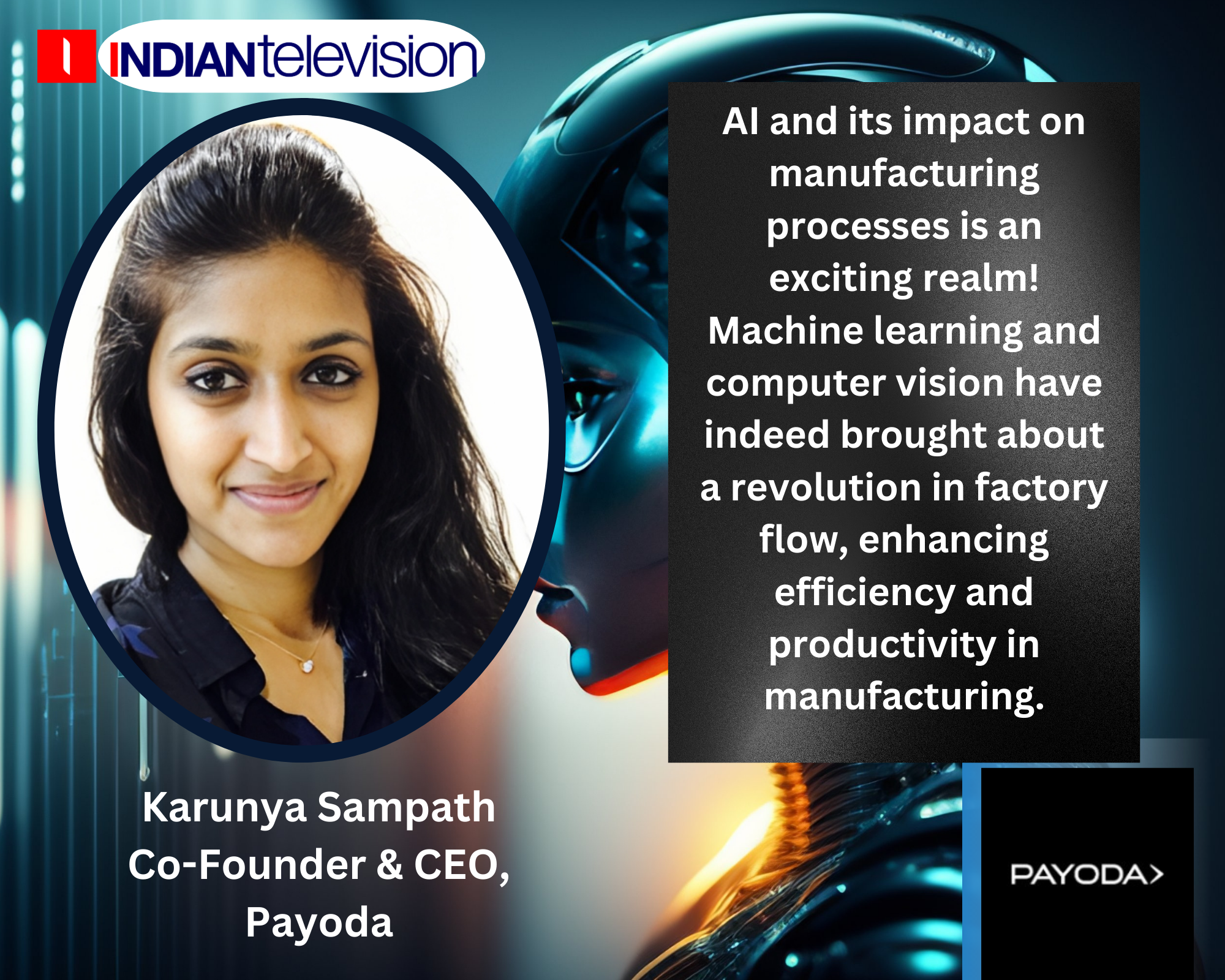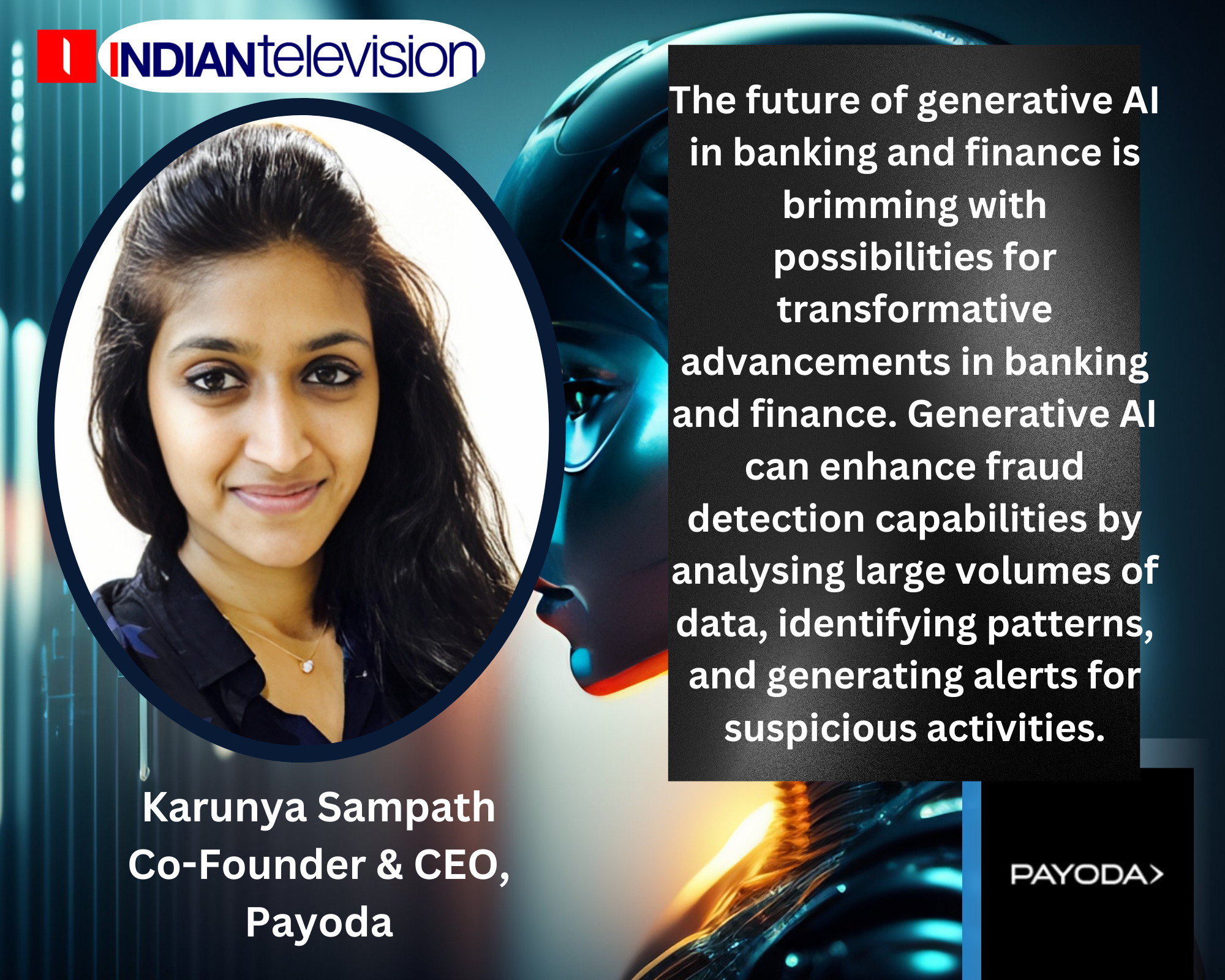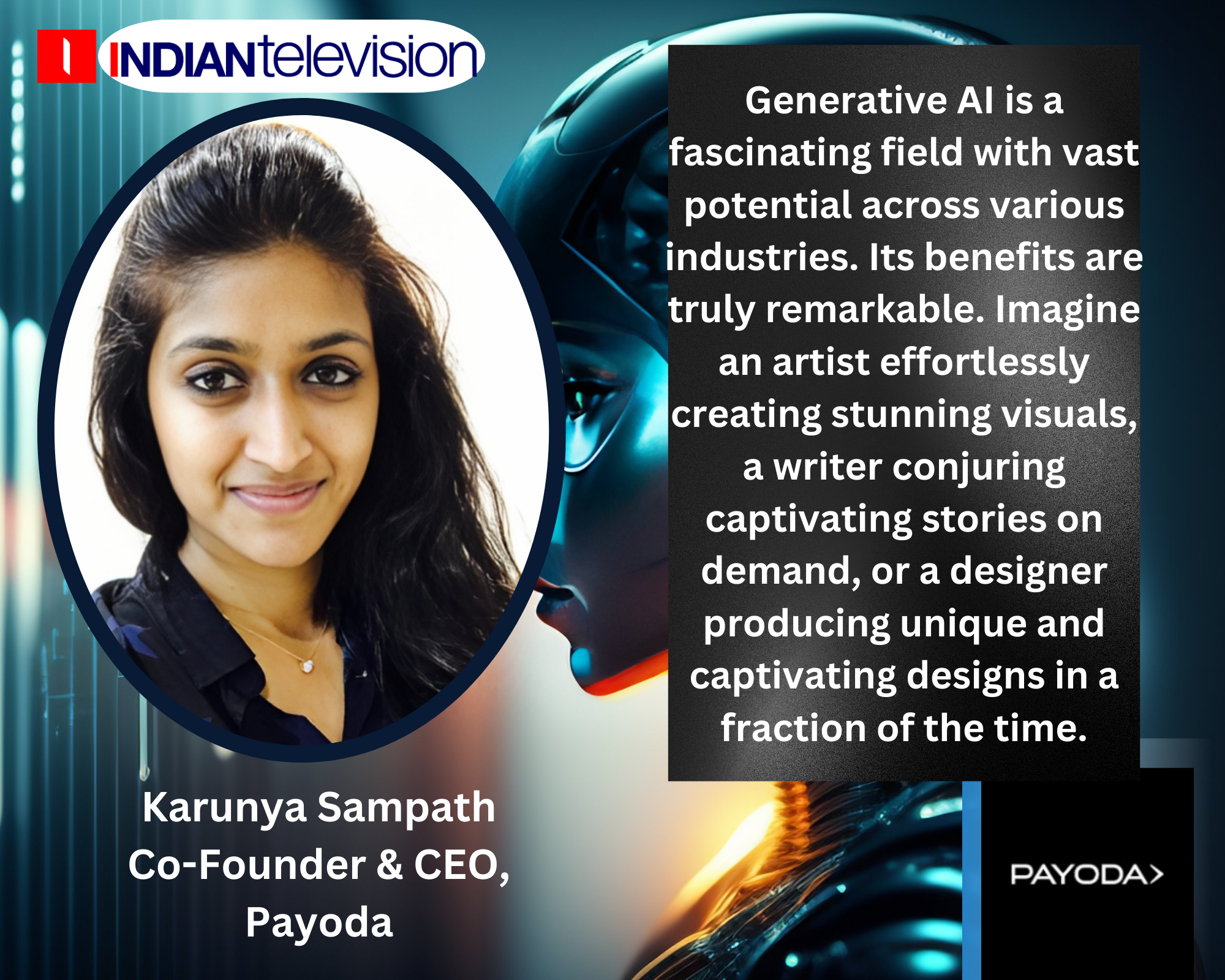Mumbai: The Company had in 2009 established its first development centre in India, following which it went on to build Hedge Mark, which was adjudged the best managed account FinTech platform. One of Payoda’s flagship developments has been AppViewX, a Web Application that entails a centrally-managed unified solution for a data centre, which deals with multiple vendors and servers. Years later, the company unveiled a state-of-the-art care orchestration platform named HealthViewX.
A leader in the tech space with over a decade-long experience at a few reputed Wall Street firms in New York, Karunya Sampath founded Payoda along with Anand Purushothaman as a joint endeavour to transform the way businesses leveraged technology. Besides being the co-founder of the company, she spearheads the overall operations while setting the vision and defining as well as executing key strategies as Payoda’s chief executive officer.
Indiantelevision.com in an email interaction spoke to Karunya Sampath on the various technological tools which will revolutionise the manufacturing process, on the challenges of rapid IT growth and the future……
Edited Excerpts:
On AI technologies such as machine learning and computer vision revolutionising factory flow in manufacturing processes
AI and its impact on manufacturing processes is an exciting realm! Machine learning and computer vision have indeed brought about a revolution in factory flow, enhancing efficiency and productivity in manufacturing. By analysing historical data and identifying patterns, machine learning models can predict when a machine will likely malfunction, enabling timely maintenance interventions. For example, predictive maintenance can be employed to detect potential equipment failures before they occur, minimising downtime and improving overall productivity.
Another exciting application of machine learning is in quality control. By training models on large datasets of product images, computer vision algorithms can quickly and accurately identify defects in real time. This eliminates manual inspection and ensures consistent quality throughout the manufacturing process. Defective products can be swiftly placed and removed from the assembly line, preventing them from reaching customers and potentially damaging a brand's reputation.
Also, AI technologies enable factories to optimise their supply chain management. By analysing vast amounts of data, machine learning algorithms can predict demand patterns, optimise inventory levels, and suggest optimal delivery routes. This leads to more efficient logistics, reduced costs, and faster response times to customer demands.
On the potential risks or challenges that may affect IT spending growth in India and globally
While the growth of IT spending in India and globally has been remarkable, some potential risks and challenges could impact this upward trajectory. One significant risk is the volatility of global economic conditions. Economic downturns or uncertainties can reduce IT budgets as organisations prioritise cost-cutting measures. Another challenge is the increasing complexity and cost of cybersecurity. As technology advances, so do the threats and risks associated with it. Organisations must allocate a significant portion of their IT budgets to robust cybersecurity measures, including infrastructure, personnel, and advanced threat detection and prevention systems.
Technological obsolescence is yet another challenge. The IT industry evolves rapidly, with new technologies emerging and older ones becoming outdated. For instance, consider the emergence of AI in content creation. And one more is that talent scarcity in the IT sector can hinder growth. The demand for skilled IT professionals often outpaces the supply, leading to increased competition for talent and rising labour costs. Organisations may need to invest more in talent acquisition, training, and retention initiatives to overcome this challenge.
By addressing these risks and challenges, the IT industry can continue its growth trajectory in India and globally, enabling technological advancements and digital transformation. So, it's essential to be aware of these factors to ensure sustainable growth and mitigate potential setbacks.
On the future possibilities and advancements expected in the field of generative AI for banking and finance
The future of generative AI in banking and finance is brimming with possibilities for transformative advancements in banking and finance. Generative AI can enhance fraud detection capabilities by analysing large volumes of data, identifying patterns, and generating alerts for suspicious activities. Simulated scenarios based on historical data can help banks and financial institutions make informed decisions regarding loan approvals, investment strategies, and portfolio management. Moreover, virtual assistants powered by generative models can provide personalised and context-aware customer support, answering queries and assisting with financial planning.
Nowadays, Generative AI can generate insights and recommendations for portfolio optimisation, asset allocation, and risk management by analysing vast amounts of financial data. It is also being helped by the fact that Generative AI can improve natural language processing capabilities, enabling more accurate sentiment analysis, chatbots with enhanced conversational abilities, and automated document analysis for tasks like contract review and compliance. And most importantly, Generative AI can strengthen cybersecurity by generating realistic attack scenarios to test system vulnerabilities. This allows financial institutions to proactively identify and patch potential security loopholes. Embracing these advancements can lead to increased efficiency, improved decision-making, and enhanced customer satisfaction in the financial industry.

On the potential benefits and challenges of adopting generative AI in different industries
Generative AI is a fascinating field with vast potential across various industries. Its benefits are truly remarkable. Imagine an artist effortlessly creating stunning visuals, a writer conjuring captivating stories on demand, or a designer producing unique and captivating designs in a fraction of the time. Generative AI empowers artists and designers and professionals in fields like healthcare to explore new horizons. In art and design, it unlocks endless possibilities, allowing for the generation of original and awe-inspiring creations. In healthcare, generative AI analyses vast amounts of patient data to aid in disease diagnosis, treatment prediction, and personalized care, revolutionising the industry and improving patient outcomes.
However, as with any revolutionary technology, generative AI presents its own set of challenges. With increasing sophistication, responsible and ethical use becomes paramount. Issues such as intellectual property rights and content authenticity must be addressed to ensure integrity and protect creators' rights.
Another challenge arises from potential biases ingrained within generative AI models. Biases in the training data can lead to biased outputs, perpetuating societal inequalities.
Furthermore, the complexity and computational demands of generative AI algorithms can pose difficulties. Achieving high-quality results often requires substantial computational resources, limiting accessibility for industries or organisations with limited computational infrastructure.
Despite these challenges, the benefits of adopting generative AI in various industries outweigh the obstacles. The key lies in embracing this technology responsibly, fostering collaborations between technical experts and domain specialists, and continually striving for ethical and inclusive practices.

On Blockchain enabling trustworthy and auditable supply chain management and traceability in manufacturing
Manufacturers can utilise Blockchain technology to establish a transparent and tamper-proof system for tracking and verifying each step of the supply chain. Every transaction and event, including raw material movement, manufacturing processes, and distribution, can be recorded as a "block" on the Blockchain. These blocks are securely linked in chronological order, forming an immutable chain of information. The transparency and immutability of the Blockchain make it extremely challenging to manipulate or falsify data within the supply chain. All stakeholders, including suppliers, manufacturers, distributors, and customers, can access and verify the information on the Blockchain. Moreover, Blockchain enables improved traceability throughout the supply chain. Traditional systems often struggle with tracing a product's origin and journey, but with Blockchain, manufacturers can create a digital trail that captures essential details at each stage, such as raw material sources, manufacturing conditions, quality checks, and shipment information. The smart contract functionality of Blockchain further enhances supply chain management capabilities by automating processes like payment settlements, quality certifications, and compliance checks.
On implementation of blockchain-based cloud optimisation in real-world scenarios
Blockchain-based cloud optimisation has been implemented to enhance cloud computing efficiency and security in real-world scenarios. One such implementation is efficiently allocating and sharing computing resources through a decentralised marketplace. Users can directly trade or lease unused resources, enabling dynamic and cost-effective allocation. Another application is decentralised cloud storage, where data is encrypted, divided, and stored across multiple nodes, improving security and availability. Blockchain's immutability and transparency enhance trust and safety by providing audibility and enforcing security protocols through smart contracts.
Blockchain is helping in optimising service-level agreements (SLAs) by recording, monitoring, and automatically implementing terms, reducing disputes and enhancing customer satisfaction. These implementations leverage the decentralised and immutable nature of Blockchain, offering innovative solutions to address inefficiencies and security concerns in cloud computing. By optimising resource allocation, storage, trust, security, and SLA management, blockchain-based cloud optimisation improves the performance and reliability of cloud-based services.
On the immutability and transparency of Blockchain contribute to fraud prevention in the BFSI sector
Blockchain technology, with its immutability and transparency, provides robust solutions for fraud prevention in the Banking, Financial Services, and Insurance (BFSI) sector. Ensuring that data recorded on the blockchain cannot be altered, tampered with, or manipulated, creates a tamper-proof audit trail, crucial for preventing fraudulent activities. The transparency of blockchain enables all network participants to see transactions, making it easier to detect suspicious behaviour and trace fraudulent activities. These attributes contribute to fraud prevention by allowing auditors and regulators to quickly review and validate transactions, establishing secure digital identities to mitigate the risk of identity theft, and using smart contracts to minimise human error.
Advanced analytics applied to blockchain data help identify patterns and anomalies indicative of fraud, generating alerts for further investigation. Consortium blockchain networks among trusted entities enhance fraud prevention measures by facilitating secure data exchange and faster identification of fraudulent activities across multiple organisations, creating a more secure and trustworthy financial ecosystem.

On the benefits of using Blockchain for participant consent management and data sharing in clinical research
Benefits of using Blockchain for participant consent management and data sharing in clinical research: Blockchain offers several benefits for participant consent management and data sharing in clinical research. It provides a secure and tamper-resistant platform for storing and managing consent records, ensuring participant privacy and data integrity. Blockchain enables granular control over data access, allowing participants greater ownership and control over their health information. Additionally, Blockchain facilitates secure and auditable data sharing among researchers, enabling collaboration while maintaining data confidentiality and trust.
On cost savings or ROI that manufacturers have experienced through AI-driven factory flow optimisation
Manufacturers have experienced significant cost savings and ROI through AI-driven factory flow optimisation. For instance, manufacturers can reduce idle time, minimise bottlenecks, and improve overall equipment efficiency (OEE) by leveraging AI algorithms to optimise production schedules and resource allocation. This results in increased production output, reduced operational costs, and improved product quality. Some manufacturers have reported double-digit percentage improvements in OEE and cost savings in the millions of dollars by implementing AI-driven factory flow optimisation techniques.






